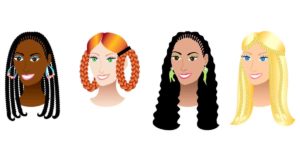
Can Tight Braids Cause Hair Loss?
Unfortunately, yes, and the term for it is traction alopecia. Alopecia means hair loss. Traction refers to the fact that the hair loss is due to tight hairstyles that pull on the scalp. The pulling can be due to braids, cornrows, ponytails, or buns that are too tight, weaves, etc. The constant pulling on the scalp causes inflammation that, over time, can lead to hair loss.
If caught early, traction alopecia is reversible. Many people starting to experience signs of traction alopecia then switch to natural styles to provide relief for their stressed follicles.
What Are The First Signs of Traction Alopecia?
- Receding hairline
- Bumps
- Widening hair part
- Scalp redness
- Itching
- Stinging or soreness
- Headaches
What Is a Protective Hairstyle?
While the term “protective hairstyle” sounds like something that might ease traction alopecia, that’s not necessarily the case. Protective hairstyles are actually designed to protect the ends of hair, not the scalp. They involve styles that tuck the ends of the hair away, so they aren’t exposed to the sun, chlorine water, heat, or anything else that can harm the ends of your hair. Although, a “protective hairstyle” can still add to traction alopecia if it’s done too tightly.
To prevent traction alopecia or give your scalp a rest, follow these guidelines:
- Wear no-risk hairstyles, such as natural curly hair, afros, etc.
- Don’t use relaxers
- Wear low-risk hairstyles like loose buns and ponytails
- Change your hairstyle periodically
- Wear moderate-risk hairstyles like loose braids, cornrows, dreadlocks, etc.
- Avoid using heat on your hair like blow dryers and curling irons.
- Use thick braids or dreadlocks
- Do not sleep in rollers
- Avoid rubber bands and elastic bindings as they can pull on hair follicles
What Are the Top Natural Hairstyle Trends for 2020?
If the buzzcut was the style for 2019, structured cuts were the trend as 2020 began. For models like Diandra Forrest, that sometimes translated to short, tapered sides with a curly high top. Though, structured cuts of natural hair can cover a wide range of styles – or did before the pandemic. The inability to visit a stylist or barber due to the outbreak has hindered this trend for many.
Another trend is long, curly hair styled as “wet & wavy strands.” It’s a classic style that looks sexy yet appropriate in a wide range of situations.
The braided bob started to catch on in 2019 and gained popularity in early 2020. This protective style is now being done at a variety of lengths despite “bob” haircuts usually implying short styles.
Adorned puffs are another cute style that features natural hair. Adorned braids are a related trendy hairstyle that is becoming more popular as well. We’ll have to wait and see which of these styles carry over to 2021 due to the pandemic.
Hair Changes? RHRLI Are the Experts
If you’re experiencing hair loss, call RHRLI for a free consultation. Hair restoration surgeon Dr. Baiju Gohil has a state-of-the-art facility using the ARTAS® Robotic Hair Restoration System. Contact RHRLI for a personal consultation with Dr. Gohil himself to assess whether robotic hair restoration is appropriate for you. Learn more by contacting us today.
